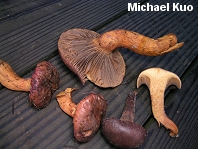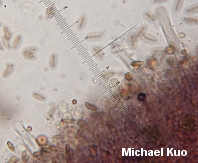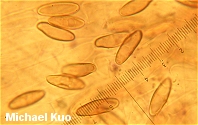| Major Groups > Gilled Mushrooms > Dark-Spored > Chroogomphus > Chroogomphus vinicolor |

|
Chroogomphus vinicolor [ Basidiomycetes > Boletales > Gomphidiaceae > Chroogomphus . . . ] by Michael Kuo Pale orange flesh, a black spore print, gills that run down the stem, and cap that usually develops purplish red shades by maturity are the visible features that define this attractive species of Chroogomphus. Unfortunately for those who really care, the very similar Chroogomphus rutilus shares--or can share--these features. The cap color is so variable in both species that the best that can be said is that Chroogomphus vinicolor, as its Latin name suggests, is usually wine colored, while Chroogomphus rutilus is often more yellow or brown. Add to this confusion the fact that North American versions of "Chroogomphus rutilus" turn out to be quite distinct, genetically, from European versions--but genetically identical to Chroogomphus ochraceus (a species described from North America as having yellower colors but apparently varying to purplish red), necessitating a name change from rutilus to ochraceus on our continent. Ultimately, it is the thickness of the walls of the cystidia that appears to separate the two species morphologically; Chroogomphus vinicolor has thick-walled cystidia (the walls reach 5-7.5 µ at their widest points), while Chroogomphus Description: Ecology: Mycorrhizal with conifers, especially pines; growing alone, scattered, or gregariously (occasionally in small clusters); fall (over winter in coastal California); widely distributed in North America. Cap: 2-10 cm wide; irregularly pointed, bell-shaped, or convex; smooth or with tiny appressed hairs; slimy when fresh and young, but often dry and shiny or silky when collected; variable in color but often pale orangish to brownish or reddish brown--usually purplish red when mature. Gills: Running down the stem; distant or nearly so; pale orangish to yellowish at first, becoming grayish and finally blackish as the spores mature. Stem: 3-15 cm long; up to 2 cm wide; tapering to base; yellowish to pale orangish, developing reddish to purplish stains with age; sometimes with a ring zone from the collapsed partial veil. Flesh: Orange to pale orange or pinkish orange. Odor and Taste: Not distinctive. Chemical Reactions: Ammonia purple on cap surface and flesh; KOH purplish on cap surface and flesh; iron salts gray to black on cap, slowly blackish on flesh. Spore Print: Dark gray to black. Microscopic Features: Spores 17-23 x 4.5-7.5 µ; smooth; narrowly elliptical to nearly spindle-shaped. Cystidia fusoid-ventricose, spindle-shaped, or narrowly clavate; 112-164 x 13-20 µ; with walls reaching 5-7.5 µ wide, thickest in the middle portion. REFERENCES: (Peck, 1898) Miller, 1964. (Saccardo, 1902; Kauffman, 1925; Miller, 1964; Smith, Smith & Weber, 1979; Arora, 1986; States, 1990; Phillips, 1991/2005; Lincoff, 1992; Evenson, 1997; Barron, 1999; Miller, 2003; Roody, 2003; McNeil, 2006; Miller & Miller, 2006.) Herb. Kuo 01170502. This site contains no information about the edibility or toxicity of mushrooms. |
© MushroomExpert.Com |
|
Cite this page as: Kuo, M. (2007, October). Chroogomphus vinicolor. Retrieved from the MushroomExpert.Com Web site: http://www.mushroomexpert.com/chroogomphus_vinicolor.html |


